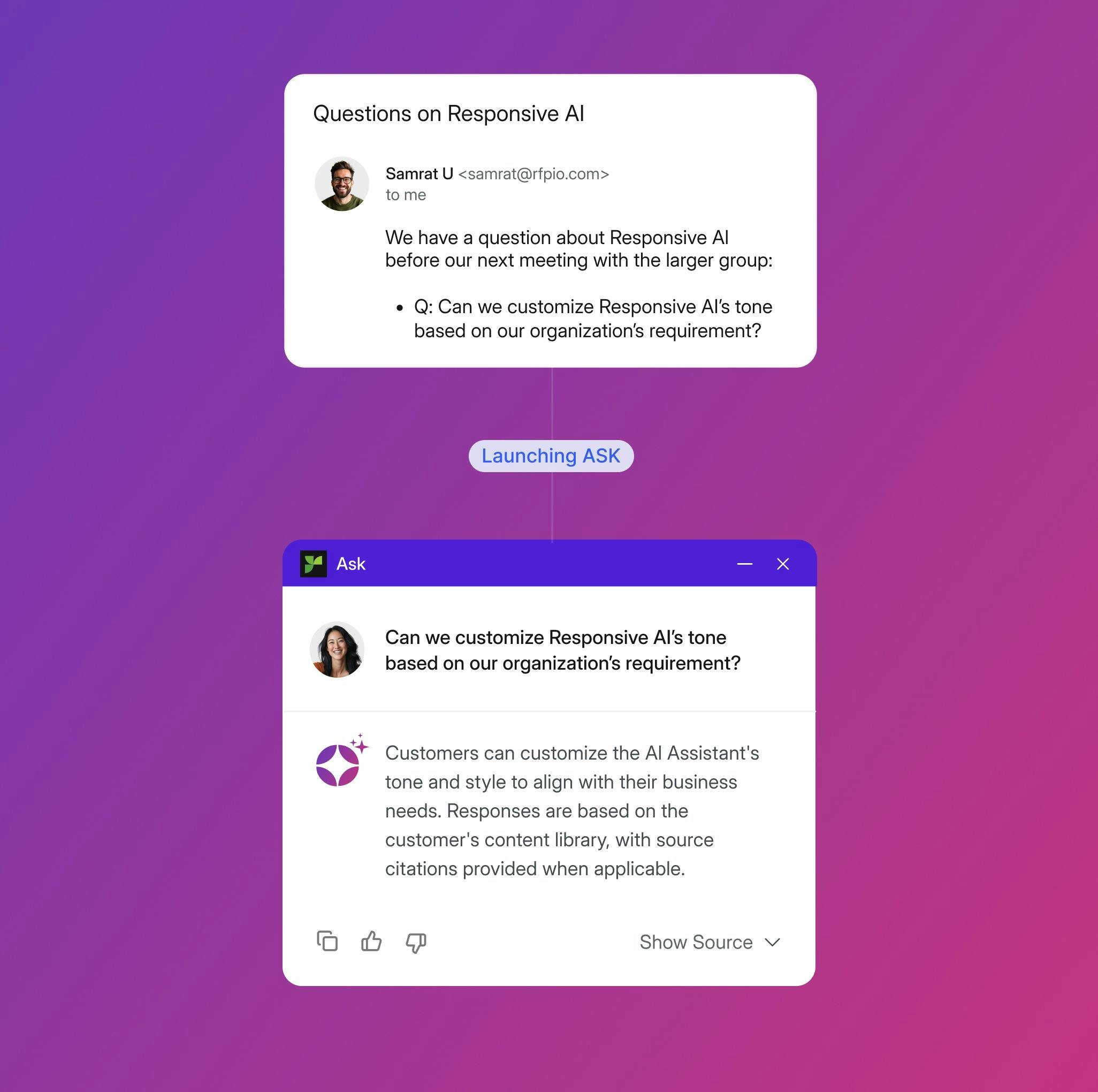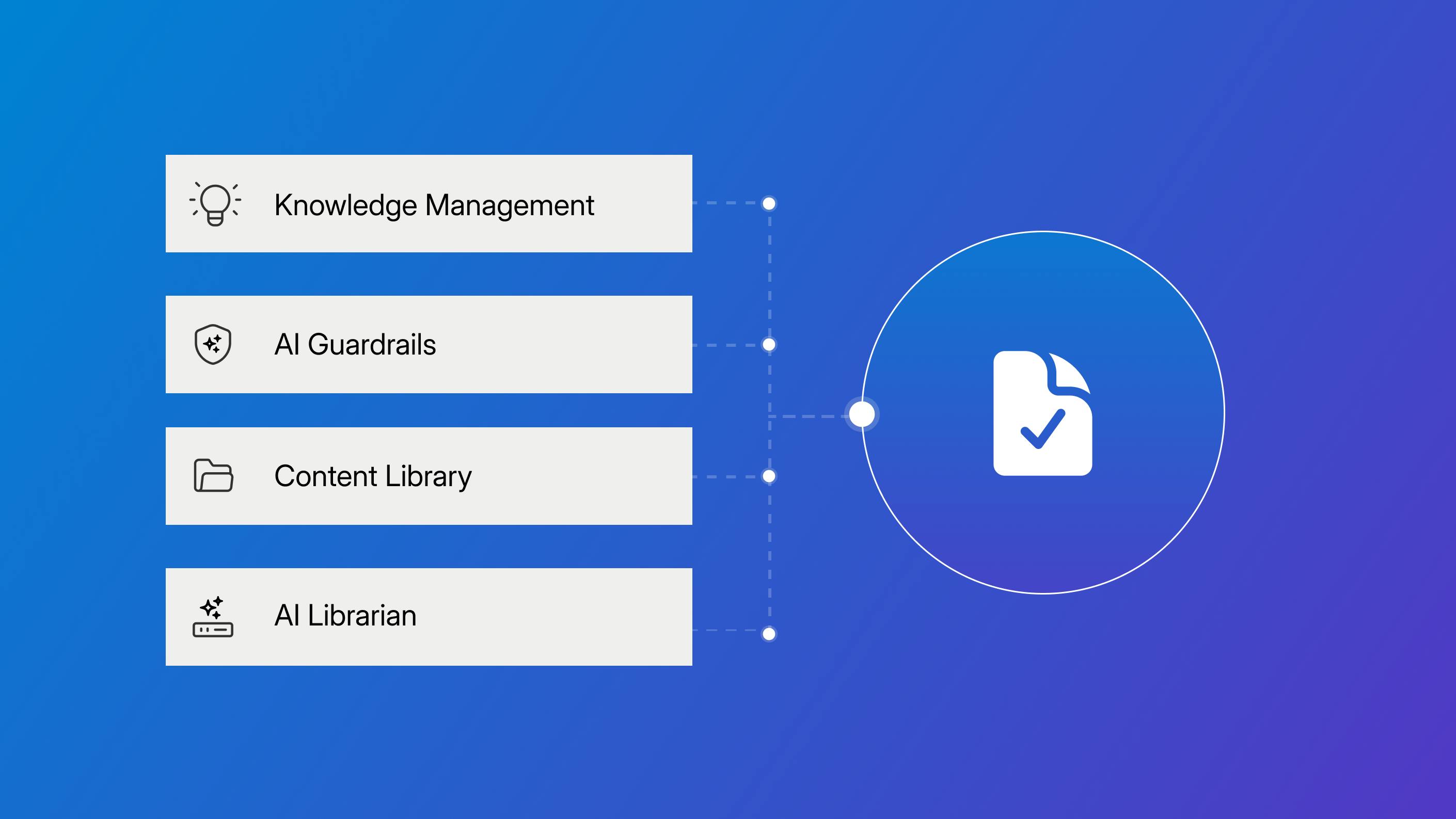Best practices for knowledge management
Deal cycles are accelerating, and complexity is increasing across every stage of the response process. Teams are expected to qualify more opportunities, assemble accurate responses quickly, and coordinate input from a growing number of stakeholders while also maintaining compliance and consistency.
Without a structured approach to knowledge management, valuable time is quickly lost searching for answers or recreating content that already exists. Managing knowledge effectively gives your organization a foundation to collaborate more efficiently, reduce repetitive work, and respond to opportunities with greater confidence.
In this post, you’ll learn strategies to capture, organize, and share knowledge so it works harder for you. We’ll cover how to centralize content, keep it accurate, enable self-service, integrate knowledge into daily workflows, encourage contributions from experts, and measure impact. By following these practices, you’ll reduce duplication, improve accuracy, and unlock faster responses across your organization.
Centralize your knowledge
The 2025 State of Strategic Response Management (SRM) Report found that top-performing companies are 53% more likely to operate from centralized knowledge hubs than their peers. Having a single source of truth strengthens speed, accuracy, and consistency across proposals, questionnaires, and customer conversations.
When content is scattered across emails, shared drives, or individual desktops, teams waste time searching for answers or recreating material that already exists. A content library, designed for reuse and supported with governance, prevents that fragmentation. With ownership rules, review cycles, and metadata in place, employees can access the most current and reliable information whenever they need it.
Responsive makes this approach practical with tools built for everyday use:
- Ask allows employees to type natural language questions and get approved answers directly from the content library. Each response is cited and scored with TRACE Score™, so users know they are working with accurate, trustworthy content.
- LookUp complements this by providing keyword-driven retrieval directly inside Excel, Chrome, and online portals, where many RFPs and questionnaires are still managed.
Centralization transforms your content library into a dependable knowledge hub. Teams no longer duplicate effort or rely on guesswork. Instead, they gain immediate access to validated content, reduce repetitive questions, and improve the quality and consistency of every interaction.
Core benefits of centralization
- Faster access to accurate answers
- Greater consistency across proposals and questionnaires
- Reduced duplication of effort
- Stronger confidence in final responses
Maintain content accuracy and relevance
A content library is only as valuable as its upkeep. After all, outdated entries or missing details will only serve to erode trust which is likely to push employees to create workarounds. So how can this be prevented?
Our guide on how to build a tender content library provides the deepest dive to this question but in short, start by defining:
- Clear ownership: Each content entry should have a named owner who is accountable for keeping it current; this person is often a subject matter expert (SME) in Legal, InfoSec, or Product.
- Review cadences: Review cycles can be set based on usage and importance, supported by Responsive features like version history, usage metrics, and TRACE Score™.
- Structured tagging: Metadata and tagging also play a major role. Labeling entries by product, geography, approval status, and more ensures content is easy to find and safe to reuse. AI can assist with duplicate detection, update suggestions, and recommendations to retire unused material.
Regular maintenance keeps the library tidy, dependable, and more likely to be used. Microsoft’s proposal team, for example, increased usage of its library by 60% and saved 30 minutes per question by maintaining a well-structured, AI-ready repository.
Upkeep best practices:
- Assign ownership for every entry
- Set review cadences tied to usage and importance
- Apply metadata and tagging for smarter retrieval
- Retire or update outdated materials regularly
Enable self-service access
When knowledge is locked behind gatekeepers, productivity suffers. The most effective organizations address this by empowering employees to access information independently. The 2025 SRM Report shows that top-performing companies are 88% more likely to maintain a centralized knowledge hub that supports self-service.
Responsive makes this possible at scale with tools designed to meet employees where they work:
- Ask lets employees type natural-language questions and instantly receive accurate answers pulled directly from the content library, complete with TRACE Score™ validation.
- LookUp delivers keyword-based retrieval inside Excel, Chrome, and online portals, spreading access to trusted content across teams and streamlining workflows where many RFPs and questionnaires still live.
- Guided Projects provide step-by-step direction for field teams with pre-approved content blocks and built-in guardrails, ensuring compliance and accuracy while still moving quickly.
Each of these tools plays a distinct role, but they work best when combined. Together, these tools extend the reach of centralized knowledge, reduce reliance on manual searches, and make approved content accessible in the flow of work. Role-based permissions layer on top to control visibility by team, region, or seniority, so employees only see the information relevant to them.
It’s this balance of accessibility and governance that reduces manual requests, eliminates unnecessary back-and-forth with SMEs, and accelerates how fast your business can respond.

Integrate knowledge into workflows
Knowledge management works best when employees don’t need to leave their everyday tools to find answers. The best approach is to connect your content library with the systems your teams already rely on, including CRM, cloud storage, and productivity apps.
Responsive integrations make this connection possible. With native support for platforms like Salesforce, Microsoft Teams, and Slack, sellers, proposal managers, and SMEs can access and update knowledge without changing their workflow. Automated syncing ensures that when a source system changes — for example, when an updated compliance certification or revised pricing model — the content library reflects it immediately.
This depth of integration goes beyond mere convenience: Integrations eliminate silos and create a more unified environment for collaboration. They also address the gaps often found in sales enablement tools, where knowledge often exists but isn’t readily available in the tools reps use every day.
By embedding knowledge management into existing workflows, organizations strengthen adoption, ensure content stays aligned across functions, and give employees a trusted source of truth right where they work.
Foster a culture of contribution
Technology alone won’t sustain a strong knowledge management practice. Long-term success depends on encouraging employees to contribute, and this starts with recognizing and encouraging SMEs as content owners, giving them both accountability and credit.
Proposal and knowledge managers can motivate SME contribution by making contribution engaging, even gamifying the process. Scoreboards and small rewards such as digital badges for email signatures that highlight SME expertise across the company signal that contributions matter.
Gamification tactics to boost SME contributions:
- Streaks or consistency badges for consistent updates
- Team competitions with contribution sprints
- Impact scoring tied to measurable outcomes (faster reviews, higher win rates)
- Progress milestones that unlock rewards at thresholds (10, 25, 50 updates)
- Peer-to-peer recognition via nominations
- Leaderboards with tiers (Gold, Silver, Bronze)
- Spotlight features in team newsletters and meetings
- Knowledge champion titles like “Content Champion of the Month”
Equally important is showing the rest of the team how SME input moves the needle. When contributions are tied to higher-quality proposals, faster response times, or reduced InfoSec workload, the value becomes indisputable and should be recognized. Over time, this visibility builds trust in the process and normalizes the practice of knowledge-sharing among the team.
O.C. Tanner offers a strong example: by trusting SMEs and building the right frameworks, they responded to 43% more RFPs in 2024 than in 2023, and saved an average of six hours per project:
“We had a big vision that knowledge and content, with proper management, could become a powerful company asset that we could continuously access in the flow of work. Responsive has provided the system and framework for us to execute this vision.”
Blake Stillman
Director of the Strategic Solutions Team at O.C. Tanner
Want to see how building a culture of contribution can drive broader impact? Explore more examples in our customer stories for firsthand accounts of teams just like O.C. Tanner who are using smart engagement and governance to scale knowledge management effectively.
Use analytics to track, refine, and improve
Knowledge management requires you to measure its effectiveness consistently and to use that data to guide improvements. Successful teams are far more likely to analyze usage, feedback, and win/loss data to inform their strategy. Here’s how to do it.
Monitor usage and feedback
Track usage like which entries are accessed most, where employees abandon searches, and which content receives the most repeated edits. Collect direct feedback from the people who interact with the library most often. Think: proposal managers, sales teams, and SMEs who rely on the content in their daily work, as well as reviewers who frequently edit or flag responses. These groups are closest to the material and can highlight where content is unclear, outdated, or incomplete.
O.C. Tanner, for example, eliminated duplicate entries and cut $150,000 annually by embedding feedback into its update process.
Analyze performance to guide strategy
Look at which content blocks appear most often in winning proposals and dig into usage patterns, search trends, and win/loss analytics to uncover where content is working and where gaps remain. With built-in reporting tools, it becomes much easier to track important RFP metrics like win rates, content performance, and user searches for smarter refinement. Leadership teams are also building custom dashboards then using those insights to align content strategy across pursuit and go-to-market teams.
That’s the exact approach Microsoft’s team applied. As Alexis Hourselt, former Director of Microsoft’s Proposal Center of Excellence, explains: reviewing analytics allowed Microsoft’s team to refine messaging and improve win rates.
Feed insights back into content and messaging
Performance data is most valuable when it continuously informs the messages you share with customers and prospects. Win/loss analysis, search term data, and content usage trends reveal which narratives resonate in the market and where gaps remain. Teams such as JAGGAER have applied these insights to refine proposal content, strengthen go-to-market messaging, and focus on the opportunities most likely to convert:
“We were able to reduce the time maintaining our content library by 50% through the elimination of writing/editing tasks involved in each RFP response, and AI Assistant has contributed to our increasing win rate.”
Autumn Wenner
Content Proposal Specialist at JAGGAER
Linking analytics to strategy also closes the loop between pursuit execution and long-term positioning. With Responsive Business Intelligence, you can track which content blocks contribute to wins, identify recurring gaps, and share those findings with sales, marketing, and product teams. This feedback cycle keeps content relevant, aligns messaging with real market outcomes, and demonstrates a clear connection between knowledge management and revenue results.
Putting practice into action
Effective knowledge management requires a sustained commitment. It isn’t something that can be checked off once and forgotten; it demands ongoing attention to centralization, accuracy, accessibility, integration, contribution, and analytics. By making knowledge management a consistent part of daily operations, you ensure that your content library continues to support faster, higher-quality responses.
The Responsive Platform brings these practices together in one place. With centralized access, AI-driven insights, and governance tools, it helps keep content accurate, trusted, and ready for every opportunity. By sustaining this commitment, your team can improve performance across every stage of the response lifecycle, from intake through post-submission analysis.
Sustaining this commitment also means guiding AI to deliver accurate, on-brand responses. Our post on how to prompt an RFP agent shows how to get the most from a well-managed Content Library.
